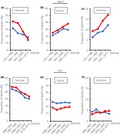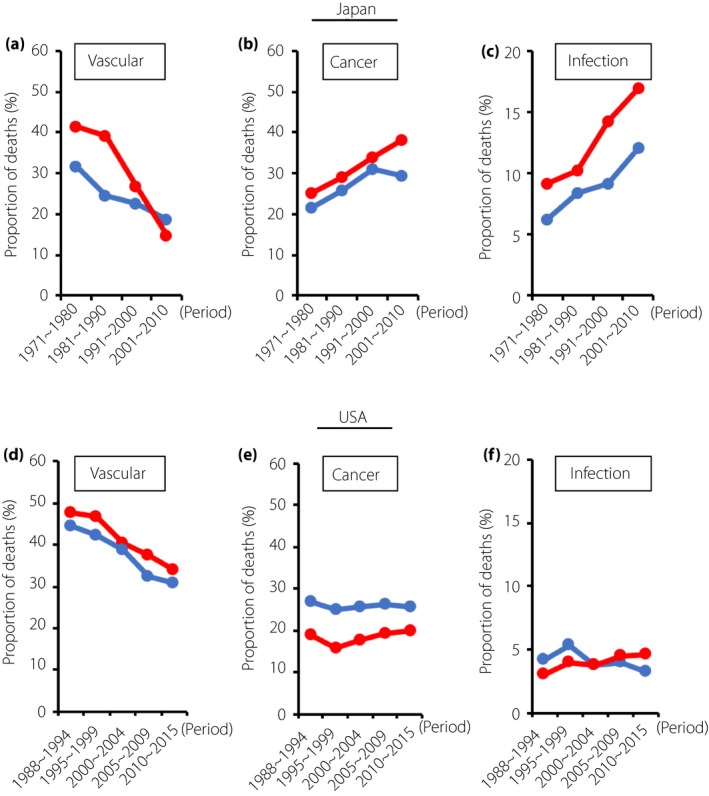Abstract
The proportion of total deaths due to vascular disease among people with diabetes has declined over the past three decades in both Japan and the USA, whereas other causes of deaths showed different trends between Japan and the USA.

The number of diabetes patients in the world is reported to have been >400 million, and the explosive increase has become global issue. The purpose of diabetes treatment is to prevent and suppress the progress of diabetic complications by improving glucose tolerance. However, the ultimate goal of diabetes treatment aims for maintaining diabetes patients’ quality of life that is equivalent to healthy people, and prolonging their life expectancy as much as possible. Along with the development of diabetes‐related medical care, there has been a significant change in the rate of diabetic complications, including vascular disease, cancer and aging‐related conditions1, 2, which is expected to change the causes of death in patients with diabetes. Thus, surveys of causes of death and age at the time of death in diabetes patients could be important to achieve the ultimate goal.
In a very recent study, Gregg et al.3 reported an epidemiological analysis of health status and causes of death among adults with and without diagnosed diabetes in the USA using data from the National Health Interview Survey Linked Mortality files from 1985 to 2015. The total number of adults with diabetes in the USA increased from 6.2 million to 21.1 million in the past three decades. The increase rate in the USA was approximately 2.3‐fold in the past two decades. It is a more rapid increase compared with the rate of 1.4‐fold in Japan. In contrast, the total mortality of adults with diabetes in the USA has declined over the past 20 years. The main conclusion of this report is that the ratio of the three classified causes of death, including vascular, cancer and non‐vascular/non‐cancer causes, has changed, and causes of death have been complex and diverse among people with diabetes.
The mortality caused by vascular diseases, which were the leading cause of death in people with diabetes, declined by 32% every 10 years among people with diabetes in the USA, and the rate of decline was significantly greater than those without diabetes. Approximately 70% of the participants in this study were non‐Hispanic whites, and the decrease of the death rate due to vascular diseases was consistent with the results of surveys of white people reported in other developed countries. Similarly, in Japan, four questionnaire surveys were carried out to investigate the causes of death in diabetes patients between 1971 and 2010 by the Committee of Japan Diabetes Society on the Causes of Death in Diabetes Mellitus. The survey in Japan4 also showed that the proportion of total deaths due to vascular diseases among people with diabetes decreased more than that among those without diabetes (Figure 1a). In addition to the development of reperfusion treatment technology for ischemic heart diseases, the large reduction in mortality due to vascular diseases could be a result of more intensive management of risk factors, including smoking cessation, blood glucose, lipid concentration and blood pressure, particularly in diabetes patients with high risk of vascular diseases in both Japan and the USA.
Figure 1.

Proportion of deaths caused by vascular diseases, cancer or infectious diseases among people with (red) and without (blue) diagnosed diabetes. (a–c) Survey in Japan4. (d–f) Survey in the USA 3.
For the past three decades, the proportion of total deaths from cancer among people with diabetes in the USA has almost been the same, and always lower than that due to vascular diseases (proportion of deaths in diabetes patients in 2010–2015; vascular disease 34.3%, cancer 19.9%; Figure 1d,e). In Japan, the proportion of total deaths from cancer in diabetes patients has continuously increased and exceeded that from vascular causes since the investigation period of 1981–1990 (proportion of deaths in diabetes patients in 2001–2010; vascular disease 14.9%, cancer 38.3%), even though the proportion of total deaths due to cancer in the general population slightly decreased in 2001–2010 (Figure 1a,b). The different trend between the two countries can possibly be explained by the fact that the rate of cardiovascular disease‐related complications among diabetes patients in the USA1 has been always higher than that in Japan2. However, over several decades, cancer‐related mortality among people with diabetes in the USA has been approximately 1.3‐fold higher than that without diabetes, implying that diabetes is associated with an increased risk for cancer.
Following vascular diseases and cancer, infectious disease has been the third highest cause of death in diabetes patients in the USA. In contrast, in Japan4, the proportion of deaths caused by infectious diseases has consistently increased (proportion in diabetes patients: 9.2% in 1971–1980, 17.0% in 2001–2010), and it has exceeded that by vascular diseases in the investigation period of 2001–2010 and been the second highest in Japanese diabetes patients (Figure 1a,c). Although Gregg et al.3 did not describe accurate information of the death rate from all kinds of infectious diseases, the estimated proportion calculated from the death rate of infectious disease, including influenza, pneumonia and sepsis, among people with diabetes in the USA showed a similar tendency with that in Japan (proportion in diabetes patients: 3.0% in 1988–1994, 4.6% in 2010–2015; Figure 1c,f), suggesting a significant association of diabetes with a compromised immune system. Furthermore, the specific cause of death has been diverse among people with diabetes in the USA, such as a significant increase of death due to chronic lower respiratory disease, Parkinson's disease, essential hypertension and renal disease. It is interesting that accidental death other than suicide tripled in the past three decades. The association with diabetes is unclear, but many studies recently have paid a lot of attention to bone fracture as a diabetic complication and the risk of motor vehicle accidents increased by hypoglycemic episodes. Furthermore, this unexpected trend could support recent large clinical trials showing the importance of diabetes treatment without severe hypoglycemia, and indirectly verified the effect of individualized targets of treatment for elderly patients with diabetes, which has been recommended in both Japan and the USA.
Although the total mortality of people with diabetes in the USA has declined, it should be noted that the mortality is still high as compared with people without diabetes (relative risk 1.6, 95% confidence interval 1.6–1.7). In the same way, the mean age at death in Japanese diabetes patients was younger by 8.2 years and 11.2 years for men and women, respectively, than the general population regardless of increasing the life expectancy of diabetes patients over the past 30 years. Therefore, diabetes treatment is still far from achieving the ultimate goal of prolonging patients’ life expectancy to be equivalent to that of healthy people. Meanwhile, in undeveloped countries, the death rate due to diabetes, vascular disorders and kidney diseases has not changed substantially over the past 30 years, even though the total mortality of the general population has tended to decline5. This opposite trend to developed countries shows that it is important to establish well‐developed healthcare systems and appropriately provide medications, such as vascular protection drugs and antidiabetic drugs, throughout the nation.
In conclusion, it is important to continuously survey causes of death from the viewpoint of diabetes treatment for individual cases and a future guide for public health policy.
Disclosure
The authors declare no conflict of interest.
Acknowledgments
This work received no specific grant from any funding agency in the public, commercial or not‐for‐profit sectors.
References
- 1. Gregg EW, Li Y, Wang J, et al Changes in diabetes‐related complications in the United States, 1990‐2010. N Engl J Med 2014; 370: 1514–1523. [DOI] [PubMed] [Google Scholar]
- 2. Sone H, Tanaka S, Tanaka S, et al Serum level of triglycerides is a potent risk factor comparable to LDL cholesterol for coronary heart disease in Japanese patients with type 2 diabetes: subanalysis of the Japan Diabetes Complications Study (JDCS). J Clin Endocrinol Metab 2011; 96: 3448–3456. [DOI] [PubMed] [Google Scholar]
- 3. Gregg EW, Cheng YJ, Srinivasan M, et al Trends in cause‐specific mortality among adults with and without diagnosed diabetes in the USA: an epidemiological analysis of linked national survey and vital statistics data. Lancet 2018; 391: 2430–2440. [DOI] [PubMed] [Google Scholar]
- 4. Nakamura J, Kamiya H, Haneda M, et al Causes of death in Japanese patients with diabetes based on the results of a survey of 45,708 cases during 2001‐2010: Report of the Committee on Causes of Death in Diabetes Mellitus. J Diabetes Investig 2017; 8: 397–410. [DOI] [PMC free article] [PubMed] [Google Scholar]
- 5. Alegre‐Díaz J, Herrington W, López‐Cervantes M, et al Diabetes and cause‐specific mortality in Mexico City. N Engl J Med 2016; 375: 1961–1971. [DOI] [PMC free article] [PubMed] [Google Scholar]


